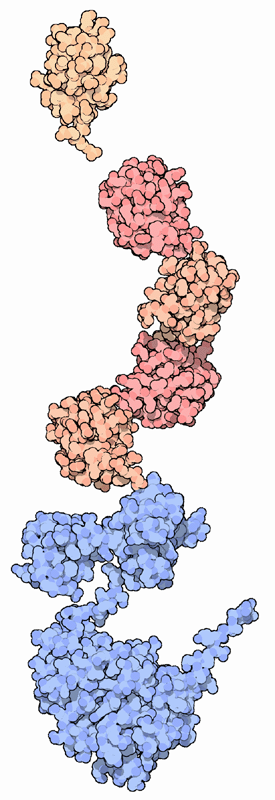|
Inhaltsübersicht | Nanomaschinen | Moleküle | Programme | Kurse | Fun | Links |
||
| > |
Ubiquitin

Nothing lasts forever. Many proteins, in fact, don't last more than a few minutes. Our cells are continually building proteins, using them for a single task, and then discarding them. For instance, proteins that are used for signaling or control, such as transcription regulators and the cyclins that control division of cells, lead very brief lives, carrying their messages and then being thrown away. Specialized enzymes are also built just when they are needed, allowing cells to keep up with their minute-by-minute synthetic needs. This approach of planned obsolescence may seem wasteful, but it allows each cell to respond quickly to its constantly changing requirements.
Out with the Old
Of course, cells need to control the destruction of their own proteins, making sure that they remove only proteins that aren't needed any more. The small protein ubiquitin plays a central role in this job. Ubiquitin is attached to obsolete proteins, signaling to the cell that they are ready to be disassembled. As shown in the figure, a string of ubiquitin molecules (colored pink and tan here, from PDB entry 1ubq) is attached to old proteins, such as the src protein shown here (colored blue, from PDB entry 2src). The ubiquitin is then recognized by the destruction machinery of the cell.Ubiquitous Ubiquitin
As its name implies, ubiquitin is found in all eukaryotic cells and in cells throughout your body. The Nobel Prize in Chemistry was awarded this year to the three researchers who discovered its essential function in 1980. In the subsequent years, it has become apparent that apart from its role in protein disposal, ubiquitin is also used for other tasks, such as directing the transport of proteins in and out of the cell. By connecting ubiquitin together in short or long chains, or using different types of linkages between the molecules, many different signals may be encoded. Because of the important roles it plays, ubiquitin has changed very little over the evolution of life, so you can find a similar form in yeast cells, plant cells, and in our own cells. For more information on ubiquitin from a genomic perspective, see the Protein of the Month at the European Bioinformatics Institute.Next: Ubiquitination
Last changed by: A.Honegger,